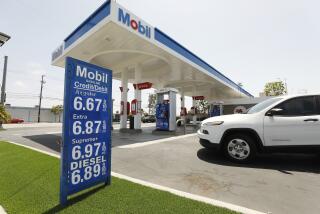This Car’s a Natural : A Quiet Arrival--on Alternative Fuel
- Share via
While electric cars have caught the public’s imagination, a wallflower--the natural gas car--has quietly become the alternative-fuel vehicle that comes closest to giving drivers the same experience they get with their gasoline-powered autos.
In fact, the practical success of these vehicles--which are expected to be widely used in polluted air basins such as those of Southern California--is one big reason why so many failed to notice their arrival.
“Natural gas vehicles are almost too transparent to the users,” says Stephanie Gott, editor of NGV News, an industry newsletter based in Tennessee. “They look like normal vehicles. There’s not a lot of glitz and glamour out there.”
Yet both Chrysler Corp. and Ford Motor Co. now offer fully warranted trucks and vans--and in the 1996 model year, Ford will offer a Crown Victoria car--that run only on compressed natural gas. Existing cars can also be converted to natural gas for $2,500 or more.
The Natural Gas Vehicle Coalition estimates that 5 million natural gas cars, trucks and vans will be on U.S. highways by the year 2000, rising to about 20 million by 2010. And the gas utilities are gearing up to deliver their fuel.
Southern California Gas Co. and San Diego Gas & Electric Co. have already installed 70 public and private fleet refueling facilities in Southern California, while the Gas Co. plans 600 more by the end of the century. The goal: that one in 10 service stations have a natural gas pump in place.
In the largest private-sector fleet order for such vehicles in this country, Super Shuttle is converting its entire Los Angeles-area fleet of 145 vehicles to natural gas. The new vans begin to arrive later this year.
And as part of the $7-million deal with Boone Pickens’ Mesa Corp., a Texas natural gas concern, Pickens is building refueling stations at LAX and John Wayne Airport in Orange County to refuel the Super Shuttle fleet and serve the public.
Critics’ early fears of explosive accidents have almost entirely subsided in the fledgling industry as fuel tanks have proven their safety.
“There really wasn’t a problem to begin with,” says Michael A. Mihelich, Chrysler technical liaison in engineering. “Look at today’s vehicle. Gasoline is a very volatile substance. People take it for granted, but we’re very diligent in our design to make gasoline vehicles safe.”
Safety questions arose when two tanks ruptured--but did not ignite--among 2,500 General Motors natural gas pickup trucks. GM is buying back all the trucks, but the problem was traced to the installation design, not the fuel tanks themselves.
Since then, the various tank designs have been subjected to much more rigorous testing than gasoline tanks--including fending off gunshots and igniting a stick of dynamite next to the tank.
“They are about the strongest part of the vehicle,” says Tom Barker, a Ford alternative-fuel program specialist.
Meanwhile, sluggish acceleration and limited range have also been improved.
Compressed natural gas needs a lot more storage room than does the gasoline to provide the equivalent amount of energy. This has forced the use of bulky, pressurized tanks that still couldn’t store enough gas to give vehicles driving range equal to gasoline cars.
Now these tanks, which often reduced trunk space to glove-compartment size, are being redesigned and mostly tucked out of the way.
Most of this progress is embodied in an advanced natural gas car designed by the Johns Hopkins University Applied Physics Laboratory, to be unveiled in Washington today. The $800,000 project was sponsored by the Department of Energy, the Gas Research Institute, Southern California Gas Co. and two East Coast utilities.
The new vehicle, converted from a Geo Prism, applied natural gas technology to a compact car for the first time. “One of our prime goals was to make it indistinguishable from the gasoline-fuel automobile,” says John J. Wozniak, project manager.
In rethinking the car, the engineers did everything they could to keep from losing trunk space to the tanks--while adding enough fuel storage to expand the car’s range. They redesigned the car’s suspension to allow more room above the rear wheels.
They also eliminated the spare tire and jack. Instead, the car runs on four so-called run-flat tires, built by Goodyear Tire & Rubber Co., which developed the tires for the 1994 Corvette. The tires can be driven up to 250 miles when flat, without incurring damage.
In all, the team was able to save 75% of the Prism’s trunk space, and it hopes that further refinements will raise that to 85%. In the meantime, while many natural gas vehicles have only enough tank storage on board to give them a 125-to-150-mile range, the Johns Hopkins car can go 300 miles between fill-ups, nearly comparable to modern gasoline-auto ranges of 240 to 375 miles.
Tanks are also being developed that could be both immensely strong but could also conform to the odd extra spaces inside a car, much as conventional gasoline tanks do. Such tanks might be made of aluminum or composite materials that were first developed for the aerospace industry.
And farther down the research road, “the Holy Grail, probably pretty far off, is adsorption technology,” says Christopher H. Norton, research project manager for the Gas Co.
This would be a storage scheme in which gas was stored in a container of material such as granulated carbon, which in theory would allow equal amounts of gas to be contained in the same space, but at much lower pressure than the 3,000 pounds per square inch used now.
Lower gas pressure would allow for lighter tanks, increasing range and energy efficiency. It would even save money on the refueling equipment, since it takes energy to compress the gas in the first place.
Such improvements could have wide impact on the workaday lives of ordinary drivers, since far more natural gas cars than electric vehicles are likely to be on U.S. roads for decades to come, as manufacturers and fleet owners meet requirements of federal and state air-pollution laws.
Natural Gas Vehicles: Pros and Cons
An improved version of the natural gas vehicle, to be unveiled in Washington today, is expected to lessen or eliminate some drawbacks of the vehicles, including lingering worries about safe handling of the fuel. Still, practical differences remain between conventional gasoline autos and natural gas vehicles. Some pros and cons of natural gas vehicles:
ADVANTAGES
* Very low-polluting
* Meets most state vehicle emissions standards
* Uses abundant domestic fuel
* Could be produced on standard assembly line
* Fuel cost per mile is currently only two-thirds that of gasoline
DISADVANTAGES
* Uses fossil, not renewable, fuel
* Slightly heavier, lowering fuel efficiency and acceleration
* Limited range
* Less trunk space
* Costs $2,000 to $4,500 more per vehicle
* Few refueling locations
More to Read
Inside the business of entertainment
The Wide Shot brings you news, analysis and insights on everything from streaming wars to production — and what it all means for the future.
You may occasionally receive promotional content from the Los Angeles Times.










